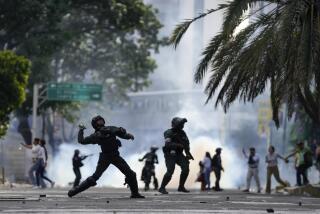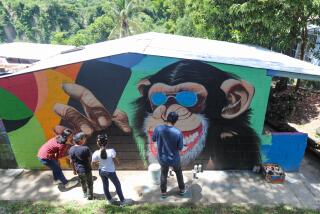Andean Region Teeters Between Anarchy, Tyranny
QUITO, Ecuador â At times when dictatorships prevailed elsewhere in Latin America, elected governments in the Andean nations withstood adversity. Yet for tens of millions of people here in Ecuador and neighboring nations, democracy seems to have delivered little more than elections.
Brutal inequality, economic breakdown and lawlessness are spawning political instability and a rise of militaristic strongmen. In different ways and to different degrees, the Andean countries are drifting toward the straits between tyranny and anarchy.
The United States has concrete reasons for concern. Colombia, Peru and Bolivia are the worldâs top sources of cocaine; Venezuela is the chief U.S. oil supplier. Regional turmoil has been accompanied by growing anti-U.S. sentiment but, at the same time, rising legal and illegal immigration to the United States.
The forces behind the crisis are the pressures of globalization to open markets, modernize economies and strengthen democratic institutions. Headlong change has toppled elitist and corrupt political structures and churned up new social forces, which lack new institutions to control them.
Consider recent events in Ecuador:
The lights went out in Congress on Aug. 1.
Someone cut the electricity during a struggle for the legislative presidency that degenerated into bottle throwing and fistfights, which continued by candlelight. Two factions claimed victory, broke into separate âcongressesâ and went about the business of legislating.
In response, President Gustavo Noboa refused to deal with either side until the Supreme Court resolved the dispute. When Noboa tried to push through sweeping, U.S.-backed privatization legislation as an emergency measure, the center-left faction accused him of wanting to emulate Peruvian President Alberto Fujimori and shut down Congress. Rumblings of unrest are increasing.
Politicians here apparently donât understand that people have had enough. Noboa came to power in January after a coup--South Americaâs first in two decades--by a ragtag alliance of army officers and indigenous activists fed up with economic chaos.
The fifth president in five years faces other classic regional woes: foreign debt consuming 40% of his budget, emergency-level crime, an exodus of emigrants overseas and of rural migrants to cities, tension between coastal financial elites and the disenfranchised indigenous peoples of the highlands.
In addition, Ecuador lies in point-blank range of Colombiaâs conflict, whose assorted combatants cross the border at will. As fighting intensifies, Ecuadoreans--and Venezuelans and Peruvians--fear a violent spillover.
Colombiaâs virtual civil war has brought a striking U.S. response in the form of a $1.3-billion aid package to fight drugs. The ills of Ecuador, Venezuela, Peru and Bolivia are less bloody but in some senses harder to confront. The latter nations offer variations on a trend that could worsen quickly if the Colombian conflict escalates or the world economy sputters.
âWe are at a very bad moment,â said Diego Garcia Sayan of the Andean Commission of Jurists, an academic and human rights organization. âThe solution is to build trustworthy democratic institutions that can resolve problems. But the big daily concern of most poor people is not whether their mayor, congressman or president was fairly elected, but rather how to fill their plate and find a job.â
The region is feeling the pressure of what some call a new invisible government--world financial institutions, foreign investors, even human rights groups, according to Bruce Bagley, a professor of international relations at the University of Miami.
âInternational and domestic pressures are causing traditional institutions to buckle in a variety of ways,â Bagley said.
The gloomiest scenario: a region dominated either by a 21st century brand of authoritarianism or profoundly dysfunctional states.
Other regions offer a stark contrast. Mexican voters recently ousted an authoritarian, 71-year-old ruling party, a breakthrough that is vital to meaningful progress. Recently, Chileâs Supreme Court enabled the prosecution of former dictator Augusto Pinochet, speeding the transition of a democracy that, like those of Brazil and Argentina, has a modernizing and competitive economy.
Generalizations can be problematic, of course. There are notable differences among the five countries that belong to the 31-year-old Andean Community of Nations. Overall, however, they share political, ethnic and geographical traits. They either avoided brutal military regimes during the past 30 years or got rid of them sooner than their neighbors in the southern cone. Colombia and Venezuela are among the longest-surviving democracies in Latin America, a fact that the more hopeful leaders see as a bright spot.
âThe perception of the problems of the Andean area are exaggerated,â said Deputy Foreign Minister Francisco Carrion of Ecuador. âOf course it is a zone of turmoil to the extent that there is injustice, unequal distribution of wealth, very grave social problems. But in spite of everything, democracy endures.â
Unfortunately, the enduring democracies were slow to pursue economic reforms that were sometimes imposed by dictatorships elsewhere. Todayâs Ecuadorean and Colombian governments struggle to provide security and basic services in large chunks of their national territories. The specter of military intervention looms in Ecuador, whose armed forces have a rural power base and are the nationâs most popular institution.
The armed forces have ominous clout in Peru and Venezuela, buttressing two paradigmatic strongmen who recently reaffirmed their power at the polls: Fujimori and Venezuelan President Hugo Chavez, a former paratroop colonel.
Last month, an isolated Fujimori put on the presidential sash for the third time while riot police battled protesters and downtown Lima burned, leaving six dead. Venezuelaâs Chavez jetted off for a defiant visit to Iraqi President Saddam Hussein after a year and a half in power marked by worrisome economic indicators, surging unemployment and crime and an erratic government response to deadly floods, the worst disaster in the nationâs history.
Fujimori and Chavez are very different men. Fujimori is a pragmatic, disciplined mathematician who doesnât waste a word. The long-winded Chavez exudes Caribbean charm and preaches a radical melange of Marxism, nationalism and anti-imperialism.
But their origins are similar. Both are anti-political populists. Both swept to power over the wreckage of traditional parties that were brought down by their own venality and irrelevance.
Chavez, who led an attempted coup in 1992, denies any dictatorial ambitions. His devoted followers argue that he has held four elections to ratify his âpeaceful revolution.â
âHe rewrote the constitution and he did away with Congress, just as he pledged,â said Hector Beltran, 42, who drives a rickety micro-bus between Caracas shack towns and opulent hilltop suburbs. âIâm not giving up on Chavez, and I donât care what the rest of the world thinks. If the rich and corrupt feel inclined to live in Miami, let them go. I wonât be losing any passengers.â
Critics say Chavez has done little more than hold elections, just like the discredited elites. His regime is under fire for restricting the independence of the courts, legislature and elections agency and failing to stamp out corruption. Divisions in the politicized military raise worries.
âI see thunderclouds ahead, and in Venezuela the storm can come fast,â said Eric Ekvall, a Caracas political consultant.
In Peru, Fujimori has had a decade to consolidate a civilian-military governing machine. His spy agency casts a shadow over the Congress, courts, press and just about every other significant institution.
Peru has globalized selectively: Economic restructuring has generated record growth rates and macroeconomic stability even as the president defies foreign and local pressure for clean elections and other reforms. The regime has hardened its tone with anti-U.S. diatribes and a strange affinity for the far-right ramblings of the U.S.-based Lyndon LaRouche movement. Although the government and opposition sat down last week to negotiate democratic reforms, the process promises to be slow.
Nonetheless, Fujimori has achieved a rarity in the region: a sense of a society under control. That is why he retains the grudging tolerance of the U.S. government, particularly in law enforcement and military circles. His regime, founded on a self-coup eight years ago, could become the model for a trend toward authoritarian governments with civilian facades and sophisticated methods of repression.
âThe militaries have learned you just canât step in with direct coups any more,â Bagley said. The Peruvian model of âan intelligence apparatus that foresees problems, harasses dissidents, shuts down newspapers is more subtle, Machiavellian and effective. But it does nothing for the institutionalization of political order.â
The panorama looks somewhat more heartening in neighboring Bolivia. President Hugo Banzer, a former dictator of the 1970s, remade himself as a civilian leader years ago and won election in 1997. His victory may show a yearning for old-fashioned order, but he governs democratically. With an elaborate system of coalitions and a knack for negotiation, Bolivia seems the most stable Andean nation.
But it is also one of the poorest and most backward nations in the hemisphere. As in Ecuador, the huge indigenous population ekes out a medieval existence a world away from the urban elite. Banzerâs militarized and U.S.-funded anti-drug campaign has eradicated coca at an astonishing clip, pushing tens of thousands of coca farmers to the wall.
The well-organized leftist unions that control the coca growers are part of a social time bomb that exploded in April. Riots against proposed water privatization in Cochabamba, near the coca heartland, flared across the country. A startled Banzer declared martial law. It was a sobering reminder of Boliviaâs potential for turmoil.
The coca factor recurs in Peru and, of course, Colombia, where drug money feeds myriad forms of violence and crime. That narco-guerrilla conflict will play a major role in the shaky future of the region.
Colombiaâs neighbors are bracing themselves, convinced that the infusion of U.S. resources will produce a crackdown in hot spots including Putumayo, a bastion of guerrillas and coca near the Ecuadorean border.
Plan Colombia, the Colombian governmentâs $7.5-billion peace and anti-narcotics blueprint of which the U.S. aid package is a part, sets aside money for Ecuador and other neighbors to shore up infrastructure and security forces against possible Colombian spillover. Already, Ecuador and Venezuela suffer kidnappings and other crimes blamed on the Colombian rebels, who have also sought contacts with leftists in neighboring nations.
The other decisive variable for the regionâs stability: global economics, particularly the health of the U.S. economy. As bad as the picture looks now, the ripples from a downturn in the United States would hit the Andean nations like tidal waves.
In any scenario, Bagley said, âitâs a very dark horizon. We are going to see a very difficult decade, both economically and for democracy, throughout the Andes.â
More to Read
Sign up for Essential California
The most important California stories and recommendations in your inbox every morning.
You may occasionally receive promotional content from the Los Angeles Times.










